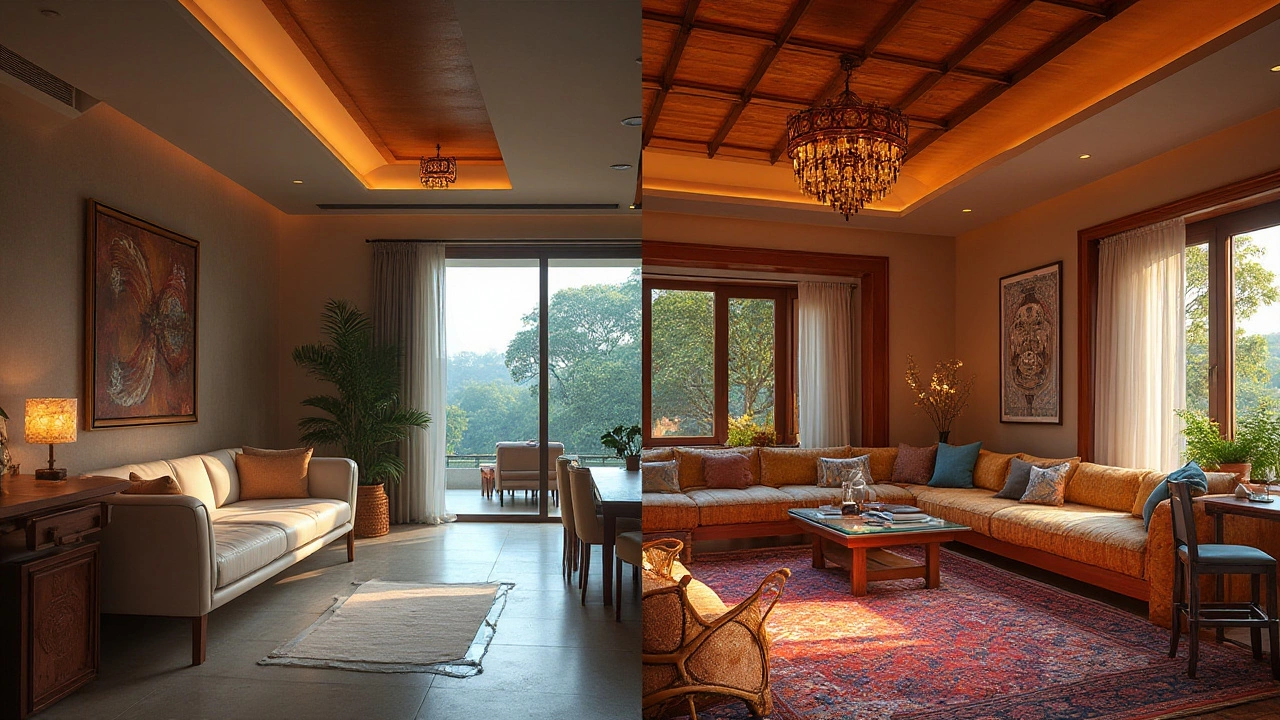Villa vs. Homestay: Understanding Key Differences for Buyers

When it comes to property investment, particularly in the world of vacation rentals, the decision often boils down to choosing between a villa and a homestay. While both offer unique experiences, catering to diverse tastes and expectations, understanding their core differences is key to making an informed choice.
Villas come with a promise of luxury and privacy, often featuring lush gardens and private pools, making them synonomous with opulent getaways. On the other hand, homestays provide a cozy, personal touch, often offering a more immersive experience in local culture and community.
In this article, we'll explore significant aspects such as privacy, amenities, cost, and personal preferences to help you determine which property type aligns best with your real estate goals. Whether you’re seeking grandeur or an intimate connection with the locality, knowing these differences will empower your decision-making in the property market.
- Defining Villas and Homestays
- Privacy and Space
- Amenities and Services
- Cost Implications
- Purpose and Personalization
- Best Fit for Different Buyers
Defining Villas and Homestays
When the topic of luxury and leisure arises, few can argue against the allure of a villa. These grand residences have long been associated with opulence and exclusivity, often located in exotic or coveted destinations. Typically standalone structures, villas offer spacious living areas, manicured gardens, and frequently, private swimming pools. Notably, they can also be architecturally significant, with designs that reflect local or historical aesthetics, blending seamlessly with their surroundings.
Villas are often part of larger luxury developments and can include concierge services, security, and access to exclusive amenities such as golf courses or private beaches. They are designed to cater to those who desire both comfort and status, making them a popular choice for high-net-worth individuals and investors in the real estate sector.
What is a Homestay?
Conversely, a homestay offers a completely different flavor of accommodation. Originating as part of the eco-tourism wave, homestays focus on providing an authentic experience, allowing guests to live as a local would. Typically, homestays involve lodging within a host's home, which may be a private room or a small, separate living area on the property.
The charm of a homestay lies in its simplicity and the personal touch it offers. Guests often share meals with their hosts, participate in family activities, or even join in local traditions and celebrations. This immersion provides travelers with a rich cultural experience that is often lacking in more commercialized accommodations.
Comparing Aesthetics and Purpose
While villas emphasize privacy and luxury, homestays focus on community and authenticity. Potential buyers should consider their personal preferences and the kind of experience they wish to offer prospective guests. Investors interested in a more intimate, personalized approach may lean towards homestays, while those wishing to emphasize luxury and seclusion might find villas more appealing.
The choice between a villa and a homestay is a reflection not only of investment goals but also of lifestyle aspirations. Each offers unique benefits, and understanding these differences can guide potential buyers towards a fulfilling and profitable decision.
Privacy and Space
One of the stark differences between a villa and a homestay is the level of privacy and the amount of space available. Villas are inherently designed to provide their inhabitants with maximum privacy. Nestled in exclusive locations, often with expansive grounds, they offer a veritable retreat from the hustle and bustle of everyday life. High walls, private gardens, and swimming pools are common features, ensuring residents can relax undisturbed.
In contrast, a homestay inherently operates on the opposite philosophy. By design, it thrives on shared spaces and interactions with hosts and fellow guests. Homestays usually offer private rooms within a house where guests share common areas like living rooms, kitchens, and gardens. While this limits privacy, it enhances the cultural experience, allowing guests to engage more deeply with local life.
Space and Layout
Villas typically boast larger living spaces compared to homestays—both indoors and outdoors. The generous layouts often include multiple bedrooms, large living areas, and extensive outdoor spaces, which are perfect for families or groups who seek a luxurious experience. This extra space is particularly appealing to those planning extended stays or hosting private events.
Conversely, the space in a homestay is more intimate. Rooms are generally designed for individual or couple occupancy. Shared kitchens or common areas encourage social interaction among guests, fostering a community feeling that many find enriching.
Privacy: A Key Consideration
For many property buyers, privacy is a deciding factor. Villas provide solitude and security, offering a secluded environment where one can enjoy personal freedom without external intrusion. This attribute makes them a preferred choice for discerning buyers looking for a blend of comfort and discretion.
Homestays, while offering a less private experience, appeal to those who value community and connection. They provide an opportunity to learn about local traditions and lifestyles directly from the host family—a feature that cannot be underestimated for cultural enthusiasts.
Ultimately, choosing between the privacy of a villa and the communal nature of a homestay hinges on personal preference and the intended use of the property. Whether you prioritize tranquility or cherish the chance to connect with locals, understanding these differences will guide you to the right investment.
Amenities and Services
The choice between a villa and a homestay can hinge on the amenities and services each offers. Both property types cater to different expectations and lifestyles, and understanding these differences can significantly impact your investment decision.
The Villa Experience
Villas are synonymous with luxury, and rightly so. Typically, they come equipped with high-end amenities such as private swimming pools, lush gardens, expansive terraces, and sometimes even personal gyms. It's not just about space; it's about creating an exclusive retreat where guests can unwind in total privacy. Many villas also come with dedicated staff services, including private chefs, housekeeping, and even concierge services to arrange excursions or spa treatments.
Privacy at Its Peak
Villas are designed to offer complete privacy, making them ideal for those seeking a secluded escape. Imagine basking under the sun by your pool with no intrusions. This level of solitude is a significant draw for celebrities and high-profile individuals, enhancing the villa's status as a premium choice.
Homestay Highlights
Homestays, in contrast, prioritize the guest's immersion into local culture. While they may lack some of the lavish extras of a villa, homestays make up for it by offering personal touches and cultural connections. A stay often includes interactions with the host family, who might share meals, traditions, and insights into the local way of life. This hospitality experience is incredibly enriching and unique to homestays.
Cultural Immersion
Homestays often come with basic amenities, but their charm lies in authenticity. Expect a cozy environment with essentials such as a comfortable bed, homemade meals, and sometimes even guided tours by the hosts themselves. This arrangement provides a different type of comfort–one that feels more like visiting family over staying in a self-contained bubble.
Comparative Overview
| Amenities | Villas | Homestays |
|---|---|---|
| Privacy | High | Moderate |
| Local Experience | Limited | High |
| Staff Services | Available | Rare |
| Cost Implications | Higher | Lower |
This table highlights the distinct features of both property types, illustrating how amenities and services differ. Prospective buyers should weigh these elements based on personal preferences and investment goals, whether seeking the indulgence of a villa experience or the warmth of a homestay.

Cost Implications
Investing in real estate, whether it's a villa or a homestay, involves significant financial considerations. Understanding the cost implications of each option is vital for potential buyers. Let's explore important facets of these costs to help you assess which property type might be a sound investment.
Initial Investment and Purchase Price
Villas generally command higher initial purchase prices due to their often larger size, prime locations, and luxurious amenities. They are typically situated in desirable areas, which can drive up the cost, making them a substantial investment. On the other hand, homestays might present a more budget-friendly option, especially when located in less commercialized areas.
Maintenance and Operational Costs
The opulent nature of villas often necessitates ongoing maintenance costs. Factor in expenses such as landscaping, pool care, and general property upkeep. These costs can add substantially to yearly budgets. Conversely, homestays are generally easier and less expensive to maintain, thanks to their smaller size and simpler amenities.
Potential Revenue and Return on Investment (ROI)
Villas, with their lure of exclusivity and privacy, often command higher rental rates compared to homestays. This could result in a noteworthy return on investment, especially in tourist hotspots. However, the higher running costs associated with villas should be carefully considered when calculating net income. Homestays, while potentially less lucrative per booking, can offer a steadier income stream, especially if they tap into niche markets appealing to cultural and budget-conscious travelers.
Example Financial Overview
| Property Type | Average Purchase Price | Annual Maintenance Costs | Average Nightly Rental Rate |
|---|---|---|---|
| Villa | $800,000 | $20,000 | $500 |
| Homestay | $300,000 | $5,000 | $150 |
This table provides a simplified overview to illustrate common financial aspects. Actual figures will vary based on location, property specifics, and market conditions. Ultimately, the choice between a villa and a homestay depends largely on your financial goals, lifestyle preferences, and desired returns.
Purpose and Personalization
When it comes to selecting a real estate option for investment or personal use, understanding the purpose and the ability to personalize the space can be a deciding factor. Both villas and homestays have distinct appeals here, each catering to different lifestyle aspirations and functional needs.
Purpose: Understanding the Use-Case
For prospective buyers, identifying the primary use-case for a property is crucial. Villas are often chosen for their potential as luxury vacation rentals or private residences. These properties appeal to those who desire a retreat-like atmosphere, offering a secluded space that is perfect for family gatherings or corporate retreats. The appeal is in the exclusive utilities and services they offer, making them ideal for guests who seek privacy and high-end amenities.
Alternatively, homestays provide a more culturally immersive experience. These are popular among buyers who want to offer guests a more genuine interaction with the local community. Homestays often mean blending hospitality with personal cultural experiences—it’s an opportunity to become part of a neighborhood, offering guests a slice of local life they wouldn’t get from a traditional hotel.
Personalization: Making It Your Own
Personalization plays a crucial role in choosing between a villa and a homestay. Villas come with the possibility of extensive customization. Owners can play with architectural elements, landscape design, and even add luxury features like home theaters or spas, which not only heighten the property’s market value but also distinguish it in a crowded vacation rental market.
In contrast, homestays, while often bound by architectural conventions that preserve their heritage, beckon personalization through interior design and offerings that highlight local craftsmanship. Customizing homestays can mean incorporating region-specific materials, local art, and furniture, which in turn can enhance the storytelling aspect pivotal for a unique guest experience.
Balancing Costs and Returns
The degree of personalization can directly impact cost implications for both villas and homestays. Investing in a villa may require higher upfront costs, but the returns can be substantial, particularly if you've crafted a unique luxury experience that commands premium rental prices. Meanwhile, homestays generally require lower initial investments, but with thoughtful marketing emphasizing authenticity, they too can yield significant returns by targeting niche markets.
The decision between investing in a villa or a homestay ultimately depends on aligning your personal goals with market feasibility. Is your vision of hosting centered around exclusivity and luxury, or do you lean towards a business model that values cultural exchange and community integration? Understanding these nuances will ensure you pick a property that not only meets your financial objectives but also your personal aspirations.
Best Fit for Different Buyers
When diving into the world of real estate, particularly with villa and homestay options, identifying the right fit for different buyers is essential. Each type of property appeals to a specific demographic and understanding this alignment is crucial in maximizing satisfaction and investment returns.
Understanding Buyer Profiles
For the luxurious lifestyle seeker, nothing surpasses the elegance and grandeur of a villa. These properties are often sought after by buyers who prioritize privacy, individual amenities like private pools, and high-end finishes. In major tourist destinations worldwide, villas are synonymous with exclusivity and indulgence.
In contrast, homestays attract buyers who value cultural immersion and personal connections over ostentatious features. Buyers looking for an intimate environment, where they can offer guests a taste of local life and traditions, often gravitate towards homestays.
The Savvy Investor
Investors focused on immediate returns and scalability might find villas appealing due to their premium rental rates. With a global trend towards multi-generational and luxury travel, villas present an opportunity for substantial yield through short-term rentals. Recent market analysis conducted by Global Travel Insights indicated, "Luxury accommodation bookings have risen by 14% over the past year, establishing villas as a lucrative investment."
The Community-Conscious Purchaser
Purchasers driven by a desire to connect more deeply with local communities may prefer homestays. Often positioned at the heart of residential areas, homestays offer a unique opportunity to blend with and contribute to local cultures. They are also generally more affordable, making them an attractive entry point for new real estate investors. As Sarah Thompson, a leading real estate consultant, aptly puts it,
"Homestays are perfect for buyers who want to make a positive community impact while still enjoying rental income. They cater to travelers wanting homey experiences."
Summary of Buyer Alignment
| Buyer Type | Preferred Property | Reason |
|---|---|---|
| Luxurious Lifestyle Seeker | Villa | Privacy, exclusivity, high-end amenities |
| Cultural Enthusiast | Homestay | Immersive experiences, cultural connectivity |
| Savvy Investor | Villa | High rental yield, premium market |
| Community-Conscious Purchaser | Homestay | Local engagement, affordability |
In closing, understanding these distinct buyer profiles can help guide your property investment decision. Whether it's relishing luxury or cultivating cultural connections, aligning with the right property type will ensure a rewarding investment journey.









Write a comment